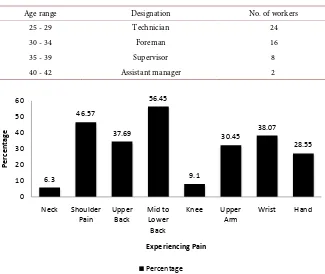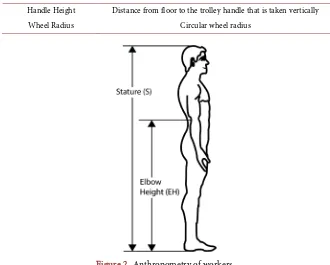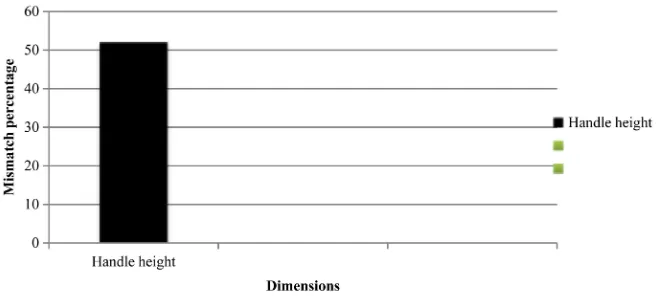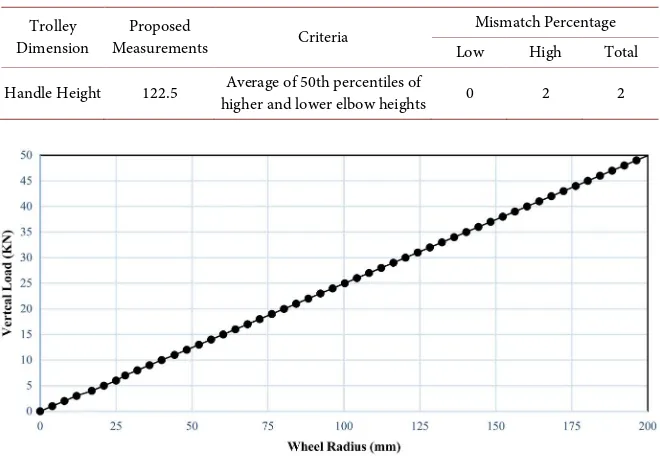ISSN Online: 2164-5175 ISSN Print: 2164-5167
DOI: 10.4236/ajibm.2019.912143 Dec. 17, 2019 2156 American Journal of Industrial and Business Management
An Ergonomic Approach for Designing of an
Industrial Trolley with Workers
Anthropometry
Subrata Talapatra, Nourin Mohsin, Mehrab Murshed
Department of Industrial Engineering and Management (IEM), Khulna University of Engineering & Technology (KUET), Khulna, Bangladesh
Abstract
Industrial trolley is an essential material handling equipment which is availa-ble in many industries and carries up to 1 ton weight. But in some cases, these trolleys are not ergonomically designed and so many workers suffer from various musculoskeletal disorders (MSDs). The purpose of this study is to find the mismatch between trolley dimension and anthropometric data. Anthropometric measurements (2) of 50 workers and dimensions (2) of in-dustrial trolley were taken and so these were differentiated. Mismatches were found out by doing chi-square test. According to a survey, workers’ expe-riencing pain was found out in their various body parts. It was found that wheel radius and handle height were too short which cause discomfort to the workers. These inspections suggest dimensions for the design of an industrial trolley so that comfort and efficiency of the workers can be ensured.
Keywords
Measurement of Anthropometry, Industrial Trolley, Trolley Design, Mismatch, Musculoskeletal Disorders, Dimensions of Trolley
1. Introduction
This research studies about designing of an industrial trolley. Industrial trolleys are essential parts of material handling that are found in various industries. They have an important role in various kinds of industrial purposes. Industrial trolleys should be made according to the anthropometric measurements of the workers. Various kinds of musculoskeletal disorders, posture defect and other causes are the reasons for the discomfort of the workers. These MSDs occur because of the mismatches between trolley dimensions and workers’ anthropometry. To reduce How to cite this paper: Talapatra, S.,
Mohsin, N. and Murshed, M. (2019) An Ergonomic Approach for Designing of an Industrial Trolley with Workers Anthro-pometry. American Journal of Industrial and Business Management, 9, 2156-2157. https://doi.org/10.4236/ajibm.2019.912143
Received: September 11, 2019 Accepted: December 14, 2019 Published: December 17, 2019
Copyright © 2019 by author(s) and Scientific Research Publishing Inc. This work is licensed under the Creative Commons Attribution International License (CC BY 4.0).
DOI: 10.4236/ajibm.2019.912143 2157 American Journal of Industrial and Business Management the MSDs, there must be higher percentage of matches between anthropometric data and trolley dimension. For this purpose, anthropometric measurement is very much essential. As workers spend most of the time on working in an indus-try, this research is very much essential not only for physical health of workers but also to enhance their efficiency.
In this research, a trolley design is proposed that will decrease the MSD’s. For this purpose, first, the anthropometric measurements of the workers were col-lected and then two parameters of the existing trolley were identified on which this research focuses on. According to the anthropometric dimensions, these two parameters were evaluated and the proper ergonomic dimension was proposed.
2. Literature Review
Study found that an intelligent platform trolley can be made to research things and analyze various loads by concentrating stress (static) at right panel, connec-tors, front and back ends of trolley [1]. Communication interaction and also ob-stacles can be avoided by using raspberry pi and also a robot for making a trol-ley. This is made to track target [2]. Research found that an ergonomic chair can improve efficiency, reduce disease caused by infection and other MSDs prob-lems. It can also improve nutrition level of elderly persons [3]. A single and double wheel trolley can be used to reduce lifting stress that is only on flat ground and also a mechanism for transporting over stairs of masses may be done by it [4]. In garments industries management of total quality is a prerequi-site for the safety of the workers also for management system implementation which is normally integrated [5] [6].
Some analyses pointed out that mismatches can be found between anthropo-metric measurements of school furniture and anthropoanthropo-metric measurements of primary school students, university furniture and anthropometric measurements of students of many universities and these mismatches can be reduced by using t-test analysis, mismatch equation and also using chi-square distribution [7] [8] [9] [10].
Again some studies found out that in a manufacturing system initial force and height range of handle is calculated while pushing a trolley [11]. Another re-search recognized that workers may suffer from MSDs for wrong design of trol-leys and hence handle height is calculated to reduce back pain and other MSDs of workers [12]. Work efficiency is increased by using a tool called pig in a pig-ging operation while handling a trolley [13]. According to another research in a material handling operation a trolley is used to lift a self-weight job keeping in the shortest distance [14]. Also quality management is important for increasing workers’ efficiency. But there are some obstacles behind it [15]. These problems have to be understood properly for ensuring workers’ safety [16].
DOI: 10.4236/ajibm.2019.912143 2158 American Journal of Industrial and Business Management are used to reduce the MSDs and other injuries of the workers [18]. Again another research found out that different types of injuries like elbow and shoul-der injuries are related to each other [19]. Some analysis found out the external force on wheel chair loading system [20]. An ergonomically designed trolley eliminates MSDs and improves efficiency [21]. Another study suggested that in cylindrical trolleys various things affect handle design but best configuration can not be found by this [22]. In marble cutting process, a transfer trolley can be de-signed and manufactured in marble industry that can reduce pain of workers [23]. A well developed and creative trolley can perform as both the airport trol-ley and shopping mall troltrol-ley [24] [25].
In short distance movement, various types of office trolleys can be used [26]. In horizontal pulling action handle design has great influence [27]. To push a cart 3D hand forces are calculated [28].
According to ergonomic study, in dryland weeder (push pull system) that is manually operated, optimum handle height is determined [29]. Other researches considered that various industrial transport carts are ergonomically made by proper handle and wheel design and to find out optimum force application, new design is being used [30]. In pushing and pulling system, handle interface for biochemical analysis is being used [31]. Study pointed out wheel design, handle height design, weight of load, direction of movement, move phase, type of floor in accordance with ergonomic rule and also their effect [32]. However, a meal mart in hospital is made by following ergonomic rules that reduce problems of previously made mart [33]. Ergonomic Compatibility also can be determined in mini-buses [34]. Some analyses found that safety awareness has a great impor-tance for reducing health hazard of workers [35]. In garments industry various critical factors are included for TQM implementation that is important for en-suring quality of work to be done [36].
Shoulder motion range can be realized by reliability test [37]. Hand tool is de-signed by considering grip diameter [38] and in horizontal pulling action handle design has great influence [39]. According to ergonomic consideration wheel-barrows, wheel, truck are designed and various types of mobile trolleys are also designed for material handling system [40].
3. Methods
3.1. Sample Population
From machine shop of an industry in Khulna, Bangladesh, sample population was taken as in the whole machine shop uses industrial trolley. The anthropo-metric measurements were taken from 50 workers (male). Only male workers were taken as the sample population because there were no female workers found in the machine shop. Permission was granted for the workers to take par-ticipation in this research by the managing director of the industry.
DOI: 10.4236/ajibm.2019.912143 2159 American Journal of Industrial and Business Management calculated (Odunaiya, Owonuwa and Oguntibeju 2014). Here, it can be seen that n = anticipated sample size, N = population size, and e = level of accuracy. In this study, N = 50, e = 5% at 95% confidence level.
n = N/(1 + Ne2). (1)
From the equation, the minimum acceptable sample size was calculated to be 44 or more. The available workers number is 50 having no physical issues and the probability of unsuitable measurements of data or inappropriate deviation in the data was reduced. The workers were given assurance of their safety before the measurements were taken.
3.2. Survey Performed
A survey was performed where questions were in a yes/no format. Pain experienced by workers was found out by this survey which helped to find out the dimensional problem of the industrial trolleys. It was found that because of handle height lower back pain occurred and for wheel MSDs occurred among the workers.
[image:4.595.211.536.433.707.2]It was also found from the survey that most of the workers who were suffering from back pain, used the trolley. But while using the trolley, they had to bend unexpectedly to drive the trolley, and so consistent use of the trolley aided in the development of back pain among its users. Also, because of the improper wheel radius, the workers had to push the trolley with excessive force which leads to MSDs among the workers. Figure 1 demonstrates the percentage of pain expe-rienced by the workers.
Table 1. Distribution population according to age and designation.
Age range Designation No. of workers
25 - 29 Technician 24
30 - 34 Foreman 16
35 - 39 Supervisor 8
40 - 42 Assistant manager 2
Figure 1. Percentage of pain experienced by the workers.
6.3
46.57
37.69
56.45
9.1
30.45 38.07
28.55
0 10 20 30 40 50 60
Neck Shoulder
Pain Upper Back Mid to Lower Back
Knee Upper
Arm Wrist Hand
Per
cen
ta
ge
Experiencing Pain
DOI: 10.4236/ajibm.2019.912143 2160 American Journal of Industrial and Business Management
3.3. Anthropometric Procedures, Dimensions and Equipments
According to studies (S. Pheasant, 2003; Kroemer and Kroemer, 1997; Weiner and Lourie, 1969), 2 anthropometric measurements of the workers in the indus-try in standing in a straight posture were taken by the researchers along with as-sistant. The measurements were taken at barefoot. The assistant reduced intra and inter observer error. Dimensions were taken in centimeter (cm). Figure 2 shows the anthropometry of workers.An anthropometric tool available in the ergonomics laboratory of Khulna University of Engineering & Technology’s Department of Industrial Engineering and Management was used. Also, slide calipers and tape were taken for taking anthropometric dimensions. These measurements were taken precisely and ac-curately.
The measurements were taken in 2 weeks and these were taken twice to en-sure that there is no error.
Following anthropometric measurements were taken for the purpose of the study from source (Standard 2003):
Stature (S) Natural height of a person
Elbow Height (EH) Distance from the floor surface to underside of elbow taken vertically
3.4. Measurement of Trolley
As local workshops manufactured or produced most of the trolleys, they are not ergonomically designed because manufacturers have lack of experience and knowledge about ergonomic facts and designs. Following parameters of an in-dustrial trolley were considered.
Handle Height Distance from floor to the trolley handle that is taken vertically
[image:5.595.207.537.455.720.2]Wheel Radius Circular wheel radius
DOI: 10.4236/ajibm.2019.912143 2161 American Journal of Industrial and Business Management
3.5. Mismatch Equations between Dimensions of Industrial
Trolley and Workers’ Anthropometry
Following ergonomic rule was evaluated to perform the mismatch equation.
Stature (S) against Handle Height (HH)
Handle height is corelated to Stature. Elbow height can be used as a proportion of overall human height or stature (S) that ranges between 66% and 77%. 3 cm allowance was added for shoe to the condition as workers wore shoes while tak-ing measurements [9]. So the followtak-ing relationship between S (Stature) and HH (Human Height) is expressed in Equation (2),
(0.66S + 3) < HH < (0.77S + 3). (2)
3.6. Levels of Compatibility
There are three kinds of conditions that were considered: 1) High mismatch which means anthropometric measurements are found to be lower than the evaluated lowest limit; 2) Low mismatch which means anthropometric mea-surements are found to be higher than the evaluated highest limit; and 3) Match which means anthropometric measurements remain within the evaluated limits.
4. Data Analysis
4.1. Measurement of Anthropometry of Workers
The calculation of 2 anthropometric measurements of industry workers such as minimum (minm), maximum (maxm), standard deviation (SD) and percentile values (5th, 50th and 95th) were performed by SPSS v25. Table 2 shows the measurements of anthropometry of workers in cm.
4.2. Existing Trolley Dimension
To calculate potential mismatch between workers’ anthropometric data and ex-isting industrial trolley dimensions, it is important to learn about the exex-isting dimensions. Table 3 shows existing trolley dimensions in cm following standard procedure.
Table 2. Anthropometric dimensions of workers.
[image:6.595.206.541.570.639.2]Dimension Minimum Maximum SD Mean Percentile Values 5th 50th 95th Stature 154.34 172.72 4.23 166.61 158.65 167.16 172.13 Elbow Height 121.84 135.99 3.25 131.28 125.16 131.71 135.53
Table 3. Existing trolley dimension.
Trolley Parameters Dimensions (cm)
Handle Height (HH) 113.2
DOI: 10.4236/ajibm.2019.912143 2162 American Journal of Industrial and Business Management
4.3. Calculation of Mismatch Equations of Existing Trolley
Dimension of trolley handle height was evaluated and match and mismatch per-centage values were listed. Table 4 shows the potential mismatch and match percentage of the existing industrial trolley.
4.4. Chi-Square Test between Anthropometric Data and Trolley
Dimensions
Chi-square test was performed and calculated statistically (Spiegel, Stephens, 2003) to find out the relationship between trolley dimensions and anthropome-tric dimensions of the workers. Table 5 shows chi-square test having 2 dimen-sions of human body with percentile values and also observed and expected val-ues.
5. Results and Discussion
5.1. Anthropometric Measurements Analysis of Workers
Table 2 shows anthropometric dimensions of workers. Mean stature, mean el-bow height, mean shoulder height, mean grip strength were the following 166.61 ± 4.23, 131.28 ± 3.25, 39.56 ± 1.39, 4.07 ± 0.276. The percentile values for Stature were 158.65, 167.16, 172.13; the percentile values for elbow height were 125.16, 131.71, 135.53; the percentile values for shoulder breadth were 37.38, 39.69, 41.72; the percentile values for grip breadth were 3.63, 4.12, and 4.49.
5.2. Analysis of Mismatch Equations
Table 4 shows that there is 52% mismatch for handle height.
From Figure 3, it was found that the existing handle height was not compati-ble with the anthropometric measurements of the workers as the mismatch per-centage was 52% which was not acceptable, as our target was to minimize the mismatch as far as possible.
5.3. Chi-Square Test Analysis
[image:7.595.208.541.597.630.2]Existing trolley dimension was compared with anthropometric data by chi-square test where the calculated values were weighed against critical values of chi-square
Table 4. Match and mismatch percentage of trolley dimensions.
Trolley Dimensions Low Mismatch High Mismatch Total Mismatch Total Match
Handle Height (HH) 52 0 52 48
Table 5. Chi-square values for trolley dimension.
Association Value Percentile Value Chi-square Values Chi-square (DF = 2) Decision 5th 50th 95th
Elbow Height (EH) and
DOI: 10.4236/ajibm.2019.912143 2163 American Journal of Industrial and Business Management
Figure 3. Mismatch percentage of dimensions of industrial trolley.
(0.103), degree of freedom (2) and 95 percent confidence level (5.33). For handle height, calculated value is larger than 0.103 (critical value). So the result was “Reject”.
5.4. Proposed Furniture Dimensions
As there were mismatches between trolley dimension and anthropometric mea-surements it was necessary to redesign of the existing trolley with proper anth-ropometric measurement to reduce the pain experienced by the workers.
Table 6 shows the mismatch percentage of proposed dimension. For handle height mismatch percentage is 2% and so there is 98% match where existing wheel radius was found to be 2.82 cm.
From Figure 4, it is found that the minimum wheel radius for a load of 1 ton should have been 4 cm. But the existing radius is 2.82 cm. As minimum re-quirement for wheel radius for 1 ton load is not satisfied, the wheel radius is considered as 4 cm in the proposed trolley dimension (Butin, Vasiliev, Tumasov, & Bagichev, 2018). Now the author recommends cast iron as a trolley material considering cost and other aspects. 2D view of an industrial trolley is shown in Figure 5. However, a comparison of existing and proposed dimension of an in-dustrial trolley is shown in Figure 6.
6. Conclusions
Workers’ efficiency and comfort at work place largely depend upon MSDs risk factors, anthropometric measurements and trolley dimension. Existing trolley dimensions had mismatch with the anthropometric measurements of the work-ers and so the trolley was designed again to reduce the MSDs of the workwork-ers.
DOI: 10.4236/ajibm.2019.912143 2164 American Journal of Industrial and Business Management
Table 6. Proposed measurements of trolley dimensions.
Trolley
Dimension Measurements Proposed Criteria
Mismatch Percentage Low High Total
[image:9.595.222.537.327.693.2]Handle Height 122.5 higher and lower elbow heights Average of 50th percentiles of 0 2 2
Figure 4. Vertical load vs. wheel radius curve.
Figure 5. 2D view of an industrial trolley.
Figure 6. Comparison of existing dimension and proposed dimension of an industrial
DOI: 10.4236/ajibm.2019.912143 2165 American Journal of Industrial and Business Management So in this research, a new trolley was introduced based on workers’ anthro-pometric measurements to increase their efficiency in workplace. For handle height mismatch percentage was lower than before, wheel radius was found out from the graph. So it can be said that proposed trolley is more acceptable than the previous one.
Conflicts of Interest
The authors declare no conflicts of interest regarding the publication of this pa-per.
References
[1] Zhang, Q., Song, M.M., Xiao, S.G. and Luo, Z. (2017) A Study on Design Method of Intelligent Platform Trolley. IOP Conference Series: Materials Science and Engi-neering, 274, Article ID: 012135. https://doi.org/10.1088/1757-899X/274/1/012135 [2] Joshi, S.N., Patki, V.K., Dixit, P.S. and Bhaldar, H. (2019) Design and Development
of Human Following Trolley.
[3] Hutasuhut, F. and Erwin (2016) Development of Anthropometric Chair Based on Arm Span, Knee Height, and Sitting Height for Elderly. International Journal of GEOMATE, 11, 2844-2850.
[4] Shiwarkar, S.S., Pairag, S.D. and Zaveri, S.R. (2018) Design and Fabrication of Easy Handling Trolley. International Research Journal of Engineering and Technology, 5, 1690-1694.
[5] Talapatra, S. and Uddin, M. (2019) Prioritizing the Barriers of TQM Implementa-tion from the Perspective of Garment Sector in Developing Countries. Benchmark-ing: An International Journal, 26, 2205-2224.
https://doi.org/10.1108/BIJ-01-2019-0023
[6] Talapatra, S., Uddin, M. and Rahman, M. (2018) Development of an Implementa-tion Framework for Integrated Management System Based on the Philosophy of Total Quality Management. American Journal of Industrial and Business Manage-ment, 8, 1507-1516. https://doi.org/10.4236/ajibm.2018.86101
[7] Biswas, B.B., Zahid, F.B., Ara, R., Parvez, M.S. and Hoque, A.S. (2014) Mismatch between Classroom Furniture and Anthropometric Measurements of Bangladeshi Primary School Students. 2014 International Conference on Mechanical, Industrial and Energy Engineering, Khulna, Bangladesh, 25-26 December 2014, 1-6.
[8] Castellucci, I., Arezes, P. and Viviani, C. (2010) Mismatch between Classroom Fur-niture and Anthropometric Measures in Chilean Schools. Applied Ergonomics, 41, 563-568. https://doi.org/10.1016/j.apergo.2009.12.001
[9] Parvez, M.S., Rahman, A. and Tasnim, N. (2019) Ergonomic Mismatch between Students Anthropometry and University Classroom Furniture. Theoretical Issues in Ergonomics Science, 20, 603-631. https://doi.org/10.1080/1463922X.2019.1617909 [10] Parvez, M.S., Parvin, F., Shahriar, M.M. and Kibria, G. (2018) Design of
Ergonomi-cally Fit Classroom Furniture for Primary Schools of Bangladesh. Journal of Engi-neering, 2018, Article ID: 3543610. https://doi.org/10.1155/2018/3543610
[11] Culvenor, J. (2005) Initial Force and Desirable Handle Height Range When Pushing a Trolley. Journal of Occupational Health and Safety-Australia and New Zealand, 21, 341-349.
Dis-DOI: 10.4236/ajibm.2019.912143 2166 American Journal of Industrial and Business Management comfort in Pushing an Industrial Trolley Using Ergonomics. IOP Conference Series: Materials Science and Engineering, 263, Article ID: 062042.
https://doi.org/10.1088/1757-899X/263/6/062042
[13] Wang, B., Wang, Y. and Lin, H.J. (2011) A New Type of Pig Handling Trolley, Ap-plied Mechanics and Materials, 84-85,347-351.
https://doi.org/10.4028/www.scientific.net/AMM.84-85.347
[14] Thete, V., Patil, R., Sarange, R., Shinde, T. and Awate, S. (2018) Design and Devel-opment of a Material Handling Trolley Operated by Self-Weight of the Job. AIP Conference Proceedings, 2018, Article ID: 020001.
https://doi.org/10.1063/1.5058238
[15] Talapatra, S. and Uddin, M.K. (2018) Some Obstacles that Affect the TQM Imple-mentation in Bangladeshi RMG Sector: An Empirical Study. Proceedings of the 8th International Conference on Industrial Engineering and Operations Management, Bandung, Indonesia, 6-8 March 2018.
[16] Talapatra, S. and Uddin, M.K. (2017) Understanding the Difficulties of Implement-ing TQM in Garments Sector: A Case Study of Some RMG Industries in Bangla-desh. 2017 International Conference on Mechanical, Industrial and Materials Engi-neering, Rajshahi, 28-30December 2017.
[17] Resnick, M.L. and Chaffin, D.B. (1995) An Ergonomic Evaluation of Handle Height and Load in Maximal and Submaximal Cart Pushing. Applied Ergonomics, 26, 173-178.https://doi.org/10.1016/0003-6870(95)00014-4
[18] Parvez, M.S. and Shahriar, M. (2018) Agricultural Farm-Related Injuries in Bangla-desh and Convenient Design of Working Hand Tools. Journal of Healthcare Engi-neering, 2018, Article ID: 4273616. https://doi.org/10.1155/2018/4273616
[19] Endo, Y. and Sakamoto, M. (2014) Correlation of Shoulder and Elbow Injuries with Muscle Tightness, Core Stability, and Balance by Longitudinal Measurements in Ju-nior High School Baseball Players. Journal of Physical Therapy Science, 26, 689-693. [20] Van Der Woude, L.H.V., Van Konlngsbruggen, C.M., Kroes, A.L. and Kingma, I. (1995) Effect of Push Handle Height on Net Moments and Forces on the Muscu-loskeletal System during Standardized Wheelchair Pushing Tasks. Prosthetics and Orthotics International, 19, 188-201.
[21] S. Wilkinson, W. (2000) Designing Trolleys for the New Millennia: An Engineering Analysis and Human Factors Concepts Approach. Proceedings of the Human Fac-tors and Ergonomics Society Annual Meeting, 44, 405-405.
https://doi.org/10.1177/1541931200044029131
[22] Okunribido, O.O. and Haslegrave, C.M. (1999) Effect of Handle Design for Cylind-er Trolleys. Applied Ergonomic, 30, 407-419.
https://doi.org/10.1016/S0003-6870(98)00053-2
[23] Aydin, A. and Kurtmen, E. (2018) The Design and Production of Transfer Trolleys Used In Marble Industry.
[24] Timbadia, V. and Bhat, R. (2018) Development of Multi-Purpose Trolley. [25] Hussein, M. (2013) Design and Analysis of Office Trolley.
[26] Fothergill, D., Grieve, D.W. and Pheasant, S.T. (1992) The Influence of Some Han-dle Designs and HanHan-dle Height on the Strength of the Horizontal Pulling Action. Ergonomics, 35, 203-212. https://doi.org/10.1080/00140139208967807
[27] Adu, G. (2015) Mismatch between Office Furniture and Anthropometric Measures in Ghanaian Institutions. International Journal of Innovative Research in Science, Engineering and Technology, 4, 2687-2693.
DOI: 10.4236/ajibm.2019.912143 2167 American Journal of Industrial and Business Management [28] AL-Eisawi, K.W., Kerk, C., Jerome, C., Alfred, A.A., Omer, C.J. and Gaines, W.G. (1098) The Effect of Handle Height and Cart Load on the Initial Hand Forces in Cart Pushing and Pulling. Ergonomics, 42, 1099-1113.
https://doi.org/10.1080/001401399185162
[29] Gite, L.P. and Yadav, B.G. (1990) Optimum Handle Height for a Push-Pull Type Manually-Operated Dryland Weeder. Ergonomics, 33, 1487-1494.
https://doi.org/10.1080/00140139008925348
[30] Wollesen, B., Argubi-Wollesen, A., Leitner, M., Schulz, S., Keuchel, M., et al. (2017) Development and Development of an Ergonomic Handle and Wheel Design for Industrial Transport Carts. Global Environment, Health and Safety, 1, 9.
[31] Lin, J.-H., McGorry, R. and Chang, C.-C. (2011) Effects of Handle Orientation and between-Handle Distance on Bi-Manual Isometric Push Strength. Applied Ergo-nomics, 43, 664-670. https://doi.org/10.1016/j.apergo.2011.10.004
[32] Jung, M.-C., Haight, J. and Freivalds, A. (2005) Pushing and Pulling Carts and Two-Wheeled Hand Trucks. International Journal of Industrial Ergonomics, 35, 79-89.https://doi.org/10.1016/j.ergon.2004.08.006
[33] Biman, D., Julia, W. and Bijon, D. (2002) Ergonomics Evaluation and Redesign of a Hospital Meal Cart. Applied Ergonomics, 33, 309-318.
https://doi.org/10.1016/S0003-6870(02)00018-2
[34] Seid, S. (2013) Ergonomics Assessment of Passenger Seats of Mini-Buses in Ethi-opia. Global Journal of Researches in Engineering Industrial Engineering, 13, 112-118.
[35] Talapatra, S., Uddin, M., Antony, J., Shivam, G. and Elizabeth, C. (2019) An Empir-ical Study to Investigate the Effects of CritEmpir-ical Factors on TQM Implementation in the Garment Industry in Bangladesh.International Journal of Quality & Reliability Management. (In Press) https://doi.org/10.1108/IJQRM-06-2018-0145
[36] Talapatra, S. and Rahman, M.H. (2016) Safety Awareness and Worker’s Health Ha-zards in the Garments Sector of Bangladesh. European Journal of Advances in En-gineering and Technology, 3, 44-49.
[37] Hayes, K., Walton, J.R., Szomor, Z. and Murrell, G. (2001) Reliability of Five Me-thods for Assessing Shoulder Range of Motion. The Australian Journal of Physio-therapy, 47, 289-294. https://doi.org/10.1016/S0004-9514(14)60274-9
[38] Wang, C.-Y. and Cai, D.-C. (2017) Hand Tool Handle Design Based on Hand Mea-surements. MATEC Web of Conferences, 119, Article ID: 01044.
https://doi.org/10.1051/matecconf/201711901044
[39] Wu, S.-P. and Hsieh, C.-S. (2002) Ergonomics Study on the Handle Length and Lift Angle for the Culinary Spatula. Applied Ergonomics, 33, 493-501.
https://doi.org/10.1016/S0003-6870(02)00024-8





